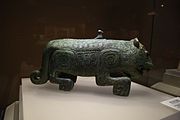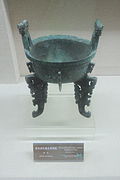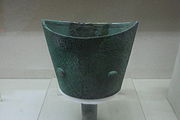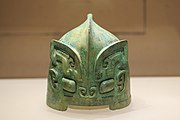Dayangzhou site
大洋洲程家遗址 | |
 | |
| Alternative name | Xingan site, Chengjia site |
|---|---|
| Location | China |
| Region | Jiangxi |
| Coordinates | 27°54′36″N 115°27′22″E / 27.91°N 115.456°E |
| History | |
| Cultures | Wucheng |
The Dayangzhou Chengjia site (Chinese: 大洋洲程家遗址) is an archaeological site located on the Gan River in Dayangzhou Town, Xingan County, Jiangxi, China. The site was excavated in 1989, and it dates to around 1200 BCE. The rich offerings of bronze and jade objects made it the second richest burial site known after the Fu Hao's tomb.
Dayangzhou was home to a rectangular tomb covered by a tumulus. Largely damaged by the sand shifts, it did not preserve the skeletal remains of coffin, making some archaeologists doubt that the find was a tomb at all.
Over 1,000 jade artefacts were discovered at Dayangzhou.
Dayangzhou is known for its unique style of bronze vessels, with 54 being discovered; over 480 bronze objects were uncovered at the site. The bronze casters at Dayangzhou copied and mastered the techniques of the Erligang culture, then localized the bronze vessels in a distinct style. Dayangzhou is associated with the Wucheng culture.
The artefacts from Dayangzhou are housed primarily in the Jiangxi Provincial Museum.
Gallery
[edit]See also
[edit]References
[edit]- Allan, Sarah (ed), The Formation of Chinese Civilization: An Archaeological Perspective, ISBN 0-300-09382-9
- The Cambridge History of Ancient China : From the Origins of Civilization to 221 BC, Edited by Michael Loewe and Edward L. Shaughnessy. ISBN 0-521-47030-7
- Zhang Liangren, Wucheng and Shang: A New History of a Bronze Age Civilization in Southern China. Bulletin of the Museum of Far Eastern Antiquities 78 (2010), 53–78








